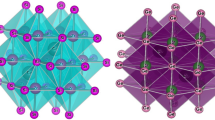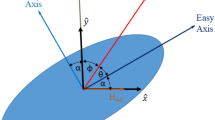Abstract
IN a recent attempt1 to separate the lattice and the electronic components of the thermal conductivity of polycrystalline rods of dilute silver–manganese alloys at liquid helium temperatures, the method of Gruneisen–De Haas2 was used. The measured thermal conductivities λ[H] in magnetic fields (including H = 0), at a temperature T, were plotted against σ[H] T (where the σ[H]'S were the corresponding electrical conductivities at that temperature). If it can be assumed that the lattice thermal conductivity (λg) and the electronic Lorentz parameter (Le) are unaffected by magnetic fields, the following relation should hold:  The isotherms were indeed found to be approximate straight lines, from which it appeared that Le is not significantly affected by magnetic fields. This method of analysis simultaneously brought out the result that (except probably at temperatures less than about 1° K.) Le, in these alloys in zero field, violated the law of Wiedmann–Franz–Lorentz in that: (1) it had a value less than the normal ‘Sommerfeld’ value Ln; (2) it was not constant with respect to temperature, even in the liquid helium region.
The isotherms were indeed found to be approximate straight lines, from which it appeared that Le is not significantly affected by magnetic fields. This method of analysis simultaneously brought out the result that (except probably at temperatures less than about 1° K.) Le, in these alloys in zero field, violated the law of Wiedmann–Franz–Lorentz in that: (1) it had a value less than the normal ‘Sommerfeld’ value Ln; (2) it was not constant with respect to temperature, even in the liquid helium region.
This is a preview of subscription content, access via your institution
Access options
Subscribe to this journal
Receive 51 print issues and online access
$199.00 per year
only $3.90 per issue
Buy this article
- Purchase on Springer Link
- Instant access to full article PDF
Prices may be subject to local taxes which are calculated during checkout
Similar content being viewed by others
References
Chari, M. S. R., Nature, 189, 824 (1961).
Kohler, M., Ann. der Phys., 5, 181 (1949).
Chari, M. S. R., Nature, 190, 994 (1961).
Schmitt, R. W., and Jacobs, I. S., Canad. J. Phys., 34, 1285 (1956).
Fischer, J. C., quoted in ref. 4.
Gorter, C. J., Van den Berg, G. J., and De Nobel, J., Canad. J. Phys., 34, 1281 (1956).
Sondheimer, E. H., and Wilson, A. H., Proc. Roy. Soc., A, 190, 435 (1947).
Alers, P. B., Phys. Rev., 101, 41 (1956).
Jan, J.-P., Solid State Physics, 5, 67 (Academic Press, Inc., New York, 1957).
Perrier, A., Helv. Phys. Acta, 3, 400 (1930).
Pugh, E. M., Rostoker, N., and Schindler, A., Phys. Rev., 80, 688 (1950).
Owen, J., Browne, M., Knight, W. D., and Kittel, C., Phys. Rev., 102, 1501 (1956).
Schmitt, R. W., Phys. Rev., 103, 83 (1956).
Scheil, E., and Wachtel, E., Z. Metallkunde., 48, 571 (1957). Scheil, E., Wachtel, E., and Kalkuhl, A., ibid., 49, 464 (1958).
Chari, M. S. R., Proc. Phys. Soc. (in the press).
De Nobel, J., and Du Chatenier, F. J., Physica, 25, 969 (1959).
Author information
Authors and Affiliations
Rights and permissions
About this article
Cite this article
CHARI, M. The Lorentz Parameter in Magnetic Fields in Dilute silver–Manganese Alloys at Helium Temperatures. Nature 193, 968–969 (1962). https://doi.org/10.1038/193968a0
Issue Date:
DOI: https://doi.org/10.1038/193968a0
Comments
By submitting a comment you agree to abide by our Terms and Community Guidelines. If you find something abusive or that does not comply with our terms or guidelines please flag it as inappropriate.



